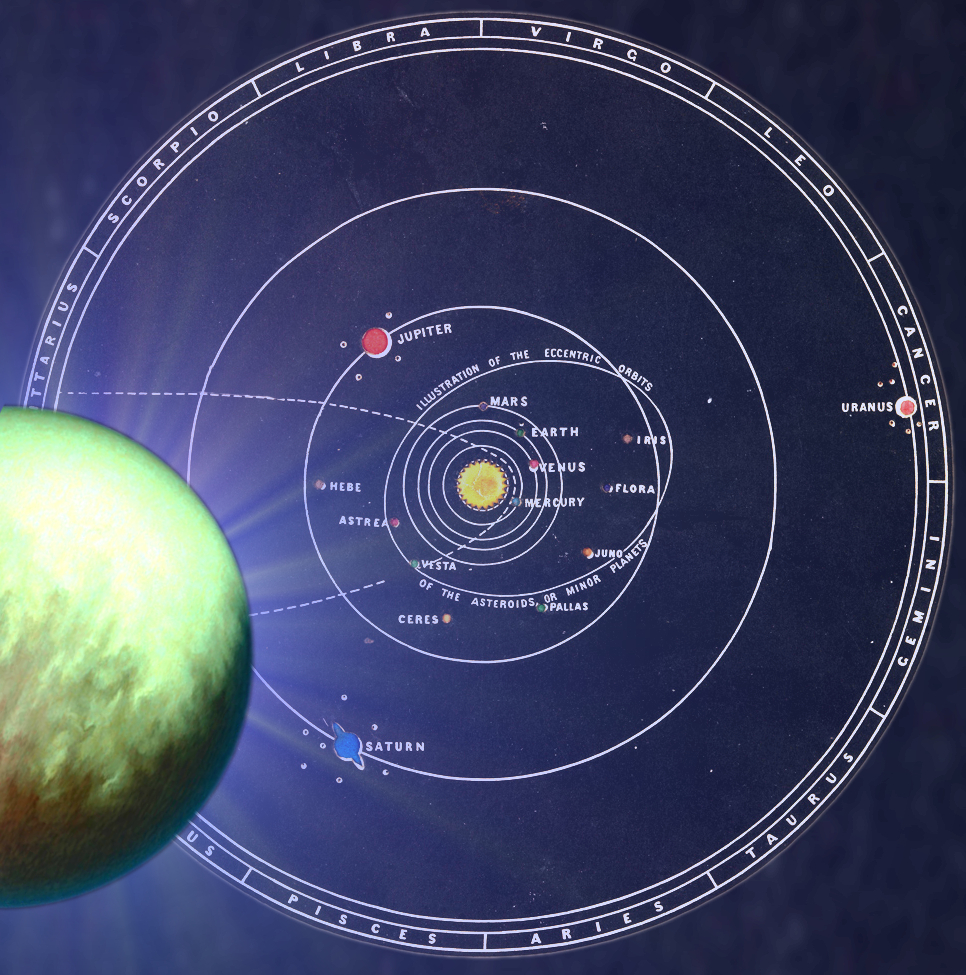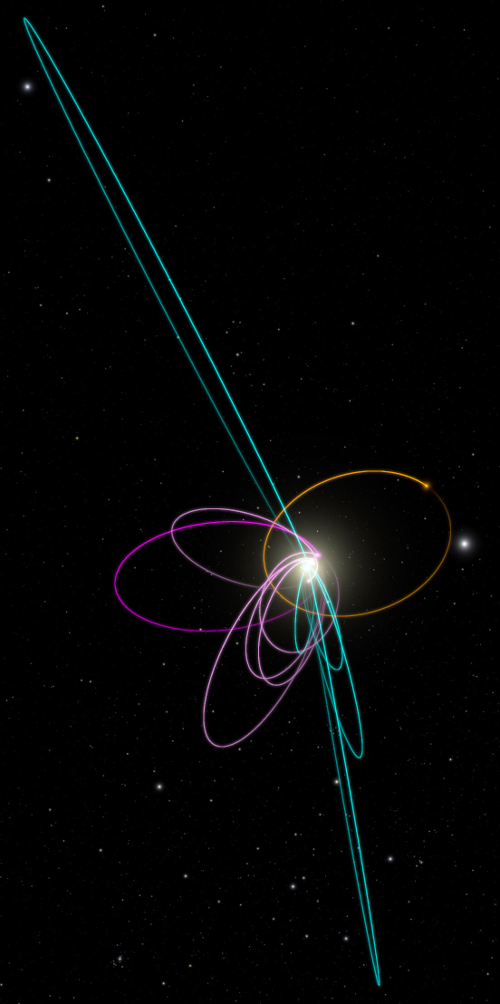Experts Orbit Notion of Ninth Planet
 There is excitement in the world of astronomy, with suggestions our solar system could contain a never-before-seen planet.
There is excitement in the world of astronomy, with suggestions our solar system could contain a never-before-seen planet.
Researchers say they have evidence that a planet about ten times the mass of Earth has been hiding in the outer solar system.
The object has been tentatively nicknamed Planet Nine, and is the subject of a new a study that aims to start the search for our long lost neighbour.
Planet Nine would be close to the mass of Neptune and its orbit is about 20 times farther from the Sun than Neptune, according to modelling of the movements of known objects in the solar system.
If it is as it seems, the new planet would take between 10,000 and 20,000 years to make just one full orbit around the Sun.
Researchers Konstantin Batygin and Mike Brown discovered the planet's existence through mathematical modelling and computer simulations, but have not yet observed the object directly.
“This would be a real ninth planet,” says Brown, a professor at Caltech in the US.
“There have only been two true planets discovered since ancient times, and this would be a third. It's a pretty substantial chunk of our solar system that's still out there to be found, which is pretty exciting.”
“Although we were initially quite sceptical that this planet could exist, as we continued to investigate its orbit and what it would mean for the outer solar system, we become increasingly convinced that it is out there,” says Batygin, an assistant professor of planetary science.
“For the first time in over 150 years, there is solid evidence that the solar system's planetary census is incomplete.”
A new report by Batygin and Brown shows how Planet Nine can explain a number of mysterious features of the field of icy objects and debris beyond Neptune known as the Kuiper Belt.
The idea that there may be a ninth planet came in a 2014 report by a former postdoc student of Brown's, Chad Trujillo, which noted that 13 of the most distant objects in the Kuiper Belt share a similar, odd orbital feature.
The students suggested these features came from the presence of a small planet. Brown thought the planet solution was unlikely, but it was interesting enough to take to his colleague, Batygin.
Batygin and Brown realised that the six of the distant objects with odd elliptical orbits actually pointed in the same direction in physical space.
It was surprising because the outermost points of their orbits were in different places around the solar system, and they travel at different rates.
“It's almost like having six hands on a clock all moving at different rates, and when you happen to look up, they're all in exactly the same place,” says Brown.
In fact, they found that the orbits of all six objects also tilted in the same way - pointing about 30 degrees downward in the same direction relative to the plane of the eight known planets. The probability of that happening is about 0.007 percent.
“Basically it shouldn't happen randomly,” Brown says.
“So we thought something else must be shaping these orbits.”
They thought it was possible that distant Kuiper Belt objects - some of which have not yet been discovered - were exerting enough gravity to keep the objects clustered together.
But the researchers quickly ruled this out when modelling showed that scenario would require the Kuiper Belt to have about 100 times the mass it has today.
Batygin and Brown then ran their simulations with a theoretical massive planet in an anti-aligned orbit - an orbit in which the planet's closest approach to the sun, or perihelion, is 180 degrees across from the perihelion of all the other objects and known planets.
Amazingly, the distant Kuiper Belt objects in the simulation ended up in the same alignment that has actually been observed.
 “I was very sceptical,” says Batygin.
“I was very sceptical,” says Batygin.
“I had never seen anything like this in celestial mechanics.”
As the researchers investigated different features and consequences of the model, they became more and more persuaded.
The big clincher was the fact that the simulations also predicted there would be objects in the Kuiper Belt on orbits perpendicular to the plane of the planets.
“Suddenly I realised there are objects like that,” recalls Brown.
In recent years, observers have identified four objects tracing orbits roughly along one perpendicular line from Neptune and one object along another.
“We plotted up the positions of those objects and their orbits, and they matched the simulations exactly,” says Brown.
“When we found that, my jaw sort of hit the floor.”
With enough indication that Planet Nine exists to get excited about, the experts have started asking where it came from, and how it ended up in the outer solar system.
Scientists believe that the early solar system contained four giant planetary cores that grabbed all the gas around them and formed the four gas planets—Jupiter, Saturn, Uranus, and Neptune.
Over time, collisions and ejections shaped them and moved them out to their present locations, “but there is no reason that there could not have been five cores, rather than four,” says Brown.
Planet Nine could represent that fifth core, and if it got too close to Jupiter or Saturn, it could have been ejected into its distant, eccentric orbit.
The tireless team is now approaching Planet Nine on two fronts – refining their models to learn more about its possible orbit and influence, while also looking for visual evidence.
Only the planet’s rough orbit is known, not its precise location on the elliptical path.
Brown says that if the planet happens to be close to its perihelion, astronomers should be able to spot it in images captured by previous surveys. If it is in the most distant part of its orbit, the world's largest telescopes will be needed to see it. New from the creators at Pragmatic Play, Sweet Bonanza Candyland is a live-action version of the classic candy-themed board game. It's also their first attempt at an entertainment-themed game, and it'll have to compete with titles like Evolution and Playtech's Crazy Time and Adventures Beyond Wonderland. Similar to the popular Sweet Bonanza slot machine, Sweet Bonanza CandyLand is a lucky wheel game show. They've stuck to the theme by recreating the candy-filled land and even including a bonus that's familiar from the slot machine.
If, however, Planet Nine is located anywhere in between, many telescopes have a shot at finding it.
“I would love to find it,” says Brown.
“But I'd also be perfectly happy if someone else found it. That is why we're publishing this paper. We hope that other people are going to get inspired and start searching.”
While it is a bizarre notion that our solar system has a member we have never seen, Batygin says it is not actually abnormal.
He says that in planetary systems that astronomers have found around other Sun-like stars, most of the planets have no single orbital range - some orbit extremely close to their host stars while others follow exceptionally distant orbits.
He also notes that the most common planets around other stars range between 1 and 10 Earth-masses.
“One of the most startling discoveries about other planetary systems has been that the most common type of planet out there has a mass between that of Earth and that of Neptune,” says Batygin.
“Until now, we've thought that the solar system was lacking in this most common type of planet. Maybe we're more normal after all.”
It may be a shot at redemption for Brown, who is best known for the significant role he played in the relegation of Pluto from a planet to a dwarf planet.
“All those people who are mad that Pluto is no longer a planet can be thrilled to know that there is a real planet out there still to be found,” he says.
“Now we can go and find this planet and make the solar system have nine planets once again.”
Batygin and Brown’s report is available here, and they can be seen discussing the discovery in the video below.








 Create PDF
Create PDF Print
Print Email to friend
Email to friend